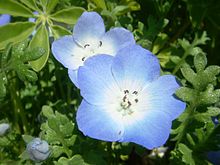
Boraginaceae, the borage or forget-me-notfamily, includes about 2,000 species of shrubs, trees, and herbs in 146 to 154 genera with a worldwide distribution.

Scaevola is a genus of flowering plants in the Goodenia family, Goodeniaceae. It consists of more than 130 species, with the center of diversity being Australia and Polynesia. There are around 80 species in Australia, occurring throughout the continent, in a variety of habitats. Diversity is highest in the South West, where around 40 species are endemic.

Nemophila menziesii, known commonly as baby blue eyes or baby's-blue-eyes, is an annual herb, native to western North America.
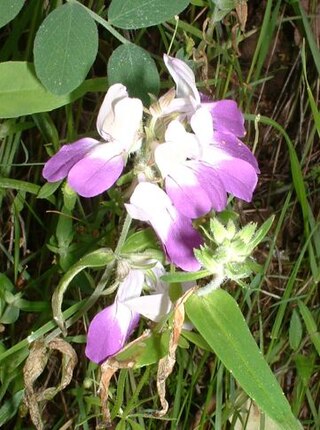
Collinsia is a genus of about 20 species of annual flowering plants, consisting of the blue eyed Marys and the Chinese houses. It was traditionally placed in the snapdragon family Scrophulariaceae, but following recent research in molecular genetics, it has now been placed in a much enlarged family Plantaginaceae.

Monardella is a genus of approximately 40 species of annual and perennial plants native to western North America from British Columbia to northwestern Mexico. They are grown for their highly aromatic foliage, which in some species is used for herbal teas. The two-lipped, tubular flowers are formed in terminal clusters and are most usually red, pink, or purple.

Nemophila maculata, commonly known as fivespot, is a species of flowering plant in the borage family (Boraginaceae).
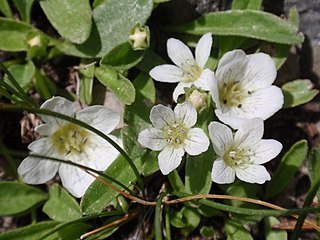
Nemophila spatulata, with the common names Sierra baby blue-eyes and Sierra nemophila, is a dicot in the family Boraginaceae.
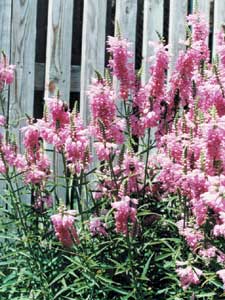
Physostegia, the lionshearts or false dragonheads, is a genus of flowering plants in the family Lamiaceae, native to North America. They are erect rhizomatous herbaceous perennials inhabiting damp, sunny places. They grow up to 2 m (7 ft) tall with purple or pink tubular flowers in racemes in summer.
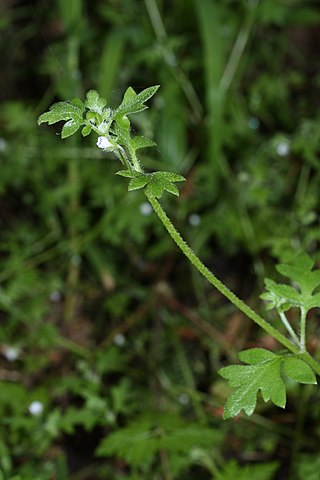
Nemophila parviflora, the smallflower nemophila, small-flowered nemophila or oak-leaved nemophila, is a dicot in the borage family, Boraginaceae, in the waterleaf subfamily, Hydrophylloideae.

Calochortus coeruleus, often misspelled as Calochortus caeruleus, is a bulbous plant of the lily family. It is known by the common name beavertail grass or blue star tulip.

Lotononis is a genus of flowering plants in the family Fabaceae and the tribe Crotalarieae. The genus includes 99 species of annual and perennial herbs, native to the southeastern Europe and Turkey, eastern Africa, and southern Africa.

Randia, commonly known as indigoberry, is a mostly Neotropical genus of shrubs or small trees in the Rubiaceae. As of February 2022 Plants of the World Online lists a total of 112 accepted species in the genus. Several Australian species have been reassigned to the genus Atractocarpus. These include the garden plants Atractocarpus chartaceus and A. fitzalanii.

Hooveria parviflora is a species of perennial herb in the subfamily Agavoideae known by the common name smallflower soap plant. It is a monocot, native to coastal southern California and Baja California, where it is a member of the coastal sage scrub flora. It resembles a smaller version of Chlorogalum pomeridianum, with wavy leaves and white flowers that open during the day.

Nymphaea nouchali, often known by its synonym Nymphaea stellata, or by common names blue lotus, star lotus, red water lily, dwarf aquarium lily, blue water lily, blue star water lily or manel flower, is a water lily of genus Nymphaea. It is native to southern and eastern parts of Asia, and is the national flower of Bangladesh and Sri Lanka. In Sanskrit it is called utpala. This species is usually considered to include the blue Egyptian lotus N. nouchali var. caerulea. In the past, taxonomic confusion has occurred, with the name Nymphaea nouchali incorrectly applied to Nymphaea pubescens.

Nemophila heterophylla is a species of flowering plant in the borage family known by the common name small baby blue eyes.
Nemophila pulchella, known by the common name Eastwood's baby blue-eyes, is a species of flowering plant in the borage family. It is endemic to California, where it is found from the San Francisco Bay Area to the southern Sierra Nevada to the Transverse Ranges. It grows in many types of mountain, foothill, and valley habitats.
